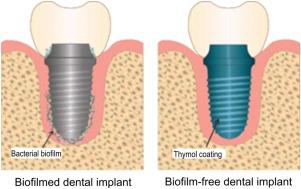Dental Materials ( IF 4.6 ) Pub Date : 2020-09-26 , DOI: 10.1016/j.dental.2020.09.006 Ariel Gonzalez , Alejandro Guillermo Miñán , Claudia Alejandra Grillo , Eduardo Daniel Prieto , Patricia Laura Schilardi , Mónica Alicia Fernández Lorenzo de Mele

|
Objective
To develop an antimicrobial and anti-adherent thymol (TOH)-containing coating on titanium (Ti) by a bioinspired one-step biocompatible method.
Methods
A nanolayer of adsorbed TOH (TOH-NL-Ti) was formed by an easy deep coating method on Ti surface. The treatment consists in a simple one-step immersion process in a TOH-containing solution. Attenuated Total Reflection Fourier Transform Infrared Spectroscopy (ATR-FTIR), potentiodynamic electrochemical technique, open circuit potential records, Atomic Force Microscopy (AFM) and measurements of TOH release were used to characterize TOH-NL-Ti. Live/Dead staining and plate counting were employed to quantify attached and living adhered bacteria, respectively. Biocompatibility and cytotoxicity in fibroblastic and pre-osteoblastic cell lines were evaluated by acridine orange staining and MTT assay, respectively.
Results
TOH adsorbed on TOH-NL-Ti was detected by ATR-FTIR and electrochemical techniques. ATR-FTIR results showed that TOH nanofilms development involves spontaneous production of ketonic structures on Ti surface. AFM analysis revealed that the thickness of the TOH-NL was below 80 nm. Finally, microbiological assays confirmed that TOH-NL-Ti can inhibit the adhesion and kill attached bacteria leading to the eradication of leaving cells on its surface. After 24 h of biocidal release, the antimicrobial effect is also significant (a decrease of 3 orders in the number of attached bacteria).
Significance
The formation of TOH-NL-Ti nanolayer is a simple strategy able to be applied by not specially trained personnel, to reduce implant infection risks, ensure highly effective antimicrobial action and inhibition of bacterial adhesion on Ti surfaces without showing toxic effects for pre-osteoblastic and fibroblastic cells.
中文翻译:

通过一步浸入法在钛表面上形成的仿生百里酚涂层的表征和抗菌作用
目的
通过生物启发式一步生物相容性方法开发在钛(Ti)上含有抗菌和抗粘附性百里香酚(TOH)的涂层。
方法
通过简单的深涂层方法在Ti表面形成了吸附的TOH纳米层(TOH-NL-Ti)。处理包括在含TOH的溶液中进行简单的一步浸入。使用衰减全反射傅里叶变换红外光谱(ATR-FTIR),电位动力学电化学技术,开路电势记录,原子力显微镜(AFM)和TOH释放的测量来表征TOH-NL-Ti。活/死染色和平板计数分别用于定量附着和附着的细菌。分别通过a啶橙染色和MTT分析评估成纤维细胞和成骨细胞前细胞系中的生物相容性和细胞毒性。
结果
通过ATR-FTIR和电化学技术检测TOH-NL-Ti上吸附的TOH。ATR-FTIR结果表明,TOH纳米膜的发展涉及Ti表面上酮结构的自发产生。AFM分析表明TOH-NL的厚度低于80nm。最后,微生物学测定证实TOH-NL-Ti可以抑制黏附并杀死附着的细菌,从而消除表面残留的细胞。杀菌24小时后,抗菌效果也很显着(附着细菌数量减少了3个数量级)。
意义
TOH-NL-Ti纳米层的形成是一种简单的策略,可以由未经专门培训的人员应用,以减少植入物感染的风险,确保高效的抗菌作用和抑制Ti表面上细菌附着的作用,而不会显示出对成骨细胞的毒性作用和成纤维细胞。











































 京公网安备 11010802027423号
京公网安备 11010802027423号